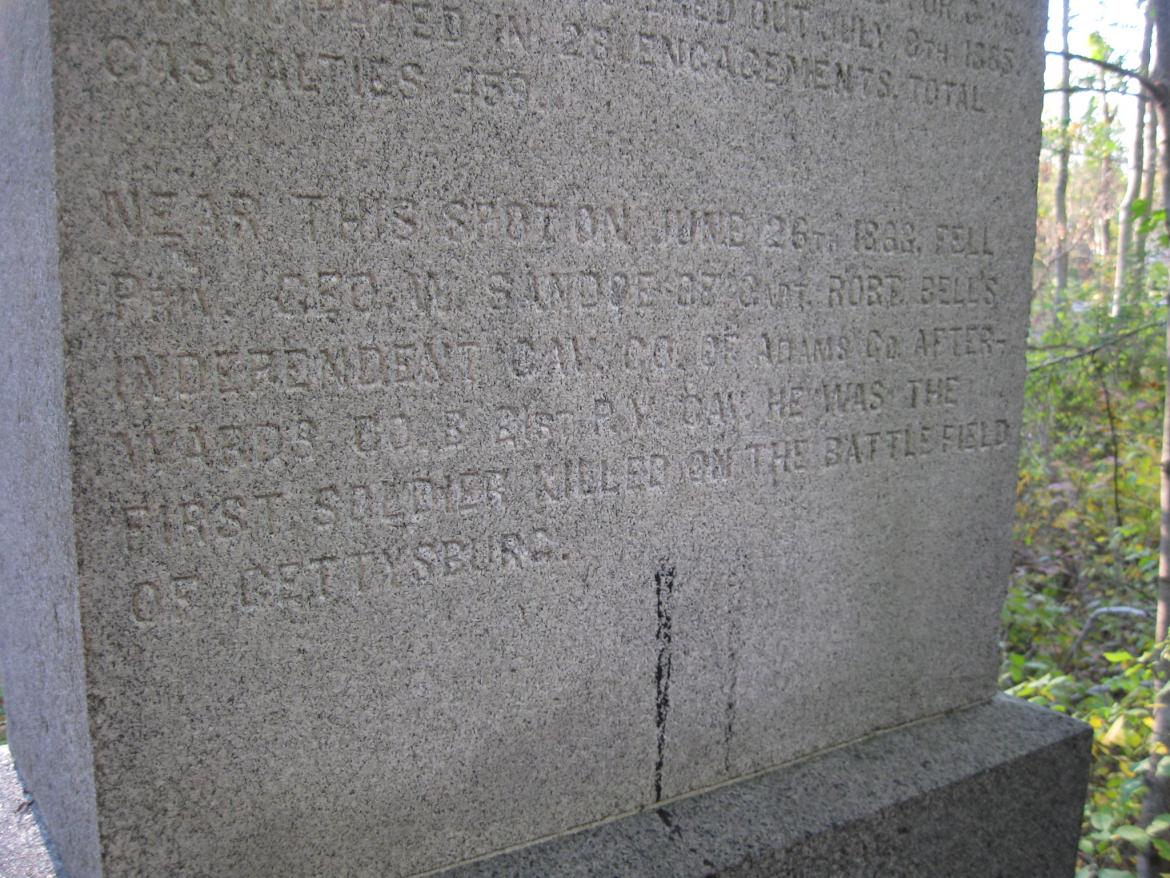George Washington Sandoe (1842-1863) was the first United States soldier to be killed in Adams County, Pennsylvania during the Gettysburg Campaign. He was killed “on the spot” on June 26, 1863 after Jubal Early’s Confederate soldiers entered the town of Gettysburg. He is shown in the photograph taken soon after his wedding with his wife Anna Caskey Sandoe. This view was taken circa 1862 and is courtesy of Fred Hawthorne.
In today’s 140 Places post, Gettysburg Licensed Battlefield Guide Fred Hawthorne shows us where George Washington Sandoe fell and was buried, and provides us new information on the A.L. Coble rock carving.
This map shows us the locations taken of the videos for the 140 Places Every Guide Should Know series. Videos #1-#9 were shown in our previous 140 Places Every Guide Should Know posts. This map was created facing north at approximately 12:00 PM on Saturday, November 13, 2010.
Gettysburg Licensed Battlefield Guide Fred Hawthorne is standing by the Mount Joy Lutheran Church located on the Taneytown Road, south of the town of Barlow. Private George Washington Sandoe is buried in the cemetery on the other (south) side of the church. Fred is pointing out that viewers to this site will have missed the Chicken Barbeque on November 6th. This view was taken facing southwest at approximately 5:15 PM on Friday, October 15, 2010.
Gettysburg Licensed Battlefield Guide Fred Hawthorne is standing by the entrance gate to the Mount Joy Lutheran Church Cemetery, located on the south side of the church. This view was taken facing southwest at approximately 5:15 PM on Friday, October 15, 2010.
Licensed Battlefield Guide Fred Hawthorne is standing by the headstone for Private George Sandoe. This view was taken facing southwest at approximately 5:15 PM on Friday, October 15, 2010.
In Video #10 (Videos #1-#9 were shown in our previous 140 Places posts) Gettysburg Licensed Battlefield Guide Fred Hawthorne shows us the grave of Private George Sandoe, of Company B, 21st Pennsylvania Cavalry. This view was taken facing norhwest at approximately 5:15 PM on Friday, October 15, 2010.
A closer view of Sandoe’s headstone. Sandoe had enlisted only three days before he was killed. This view was taken facing west at approximately 5:15 PM on Friday, October 15, 2010.
Licensed Battlefield Guide Fred Hawthorne is standing by one of two monuments located along the Baltimore Pike that were dedicated to the 21st Pennsylvania Cavalry Regiment. This one was produced with money from the Commonwealth of Pennsylvania, and was dedicated on October 14, 1894. This view was taken facing east at approximately 5:15 PM on Friday, October 15, 2010.
In Video #11 Licensed Battlefield Guide Fred Hawthorne shows the area where Private George Sandoe was killed, and where the two monuments to the 21st Pennsylvania Cavalry are located. This view was taken facing northwest to northeast to southeast to northeast at approximately 5:15 PM on Friday, October 15, 2010.
The inscription at the bottom of the State Monument mentions that George Sandoe fell near this location. This view was taken facing northeast at approximately 5:15 PM on Friday, October 15, 2010.
Approximately 20 yards south of the State Monument to the 21st Pennsylvania Cavalry is the monument to the same regiment funded and put up by the regiment. It was dedicated on October 5, 1893. This view was taken facing northeast at approximately 5:15 PM on Friday, October 15, 2010.
The inscription at the rear of the monument funded by the regiment also mentions Private Sandoe’s demise. This view was taken facing northwest at approximately 5:15 PM on Friday, October 15, 2010.
Both monuments are located close to the Baltimore Pike. In the background, the vehicles (such as the white bus) are stopped at the traffic light for the new National Park Service Visitor Center. This view was taken facing northwest at approximately 5:15 PM on Friday, October 15, 2010.
Fred Hawthorne is waiving to the photographer (and to you the audience) from atop the Coble Rock at the south side of Lower Culp’s Hill.The photographer is standing in Spangler’s Meadow where the 27th Indiana charged across the field was was shot by individuals such as Coble located in this rock. This view was taken facing northwest at approximately 5:15 PM on Friday, October 15, 2010.
Fred Hawthorne is kneeling by the A.L. Coble rock carving. Spangler’s Meadow is lost in the background glare. This view was taken facing southwest at approximately 5:15 PM on Friday, October 15, 2010.
In Video #12 Fred Hawthorne is standing on the Coble Rock and points out the Coble rock carving. He also provides information on when Coble actually produced the carving. This view was taken facing northeast to south to northeast at approximately 5:15 PM on Friday, October 15, 2010.
Fred Hawthorne believes that the A.L. Coble rock carving was produced during the 1913 Gettysburg Reunion. This view was taken facing southwest at approximately 5:15 PM on Friday, October 15, 2010.














